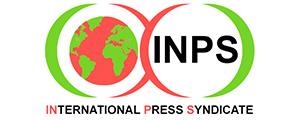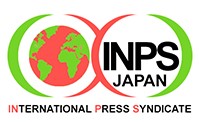By Francesca Dziadek | IDN-InDepth NewsFeature
BERLIN (IDN) – A leap of faith is on the agenda in Berlin where a visionary project for interfaith dialogue, launched as the House of One, hopes to bring Christians, Jews and Muslims to worship under one roof from 2018.
In a country where inter-religious dialogue has spun numerous initiatives for Christian-Jewish dialogue set up after World War II (1939-45) and post 9/11 – the time after a series of four coordinated terrorist attacks upon the United States in New York City and the Washington, D.C. on September 11, 2001 – public opinion in Germany has yet to come to terms with how it was possible for six million Jews to be murdered by the citizens of a Christian nation.
Sharing a symbolic shoe-burying ritual in the sandy soil of an empty plot of wasteland in Berlin’s historic centre, not far from the building site for new Humboldt Cultural Forum, an unlikely trio – a Pastor, a Rabbi and an Imam – stood side by side in June thanking the shared God of the three Abrahamic faiths they hope to come and pray to once the bold Church-Synagogue-Mosque in one building is completed.
Rabbi Tovia Ben-Chorin, Imam Kadir Sanci and Pastor Gregor Hohberg, the House of One’s initiators, are poised to become Berlin’s own “Tolerance Trio”: a term which refers to the U.S. interfaith National Conference of Christians and Jews in the 1930s, whereby a rabbi, a priest, and a minister – the “Tolerance Trio” – were dispatched to cities around the country in order to facilitate interfaith understanding promoting the idea of an America built on harmony among Jews, Catholics, and Protestants.
When in 1943 a German U-boat torpedoed the USS Dorchester and it began to sink – a rabbi, a priest, and a minister – helped to distribute life vests until they ran out and finally gave up their own to save more soldiers. Survivors saw the men praying arm-in-arm as the ship went down.
Standing on firmer ground, the House of One’s management board which includes Roland Stolte, House of One’s Project Manager, Cebrail Terlemez, Chairman of the Muslim Forum for Intercultural Dialogue (FID), – and Maya Zehden have been joined by a roster of prestigious names including Walter Homolka, Rector of the Abraham Geiger College, and Dr Gideon Joffe, Chairman of the Jewish Community Berlin. Berlin’s Senate Department for Urban Development and the Federal Ministry of the Interior are on the supervisory board.
Set up in 2011 as the association House of Prayer and Learning Petriplatz Berlin e.V. the Church-Synagogue-Mosque project is envisioned as a uniquely independent public venture, free from official sponsors and partisan donations. Backers and supporters, hope to raise 43.5 million Euros by 2016 through by collaborative crowdfunding encouraging anyone to donate – starting from a single, symbolic brick for 10 Euros. At least 10 million Euros will be required to complete a first phase of the project, which will not draw funds from the German church tax.
Spiritual foundation
The selected location, Peritzplatz, is none other than Berlin’s spiritual foundation.
When excavations in 2009 revealed remnants of Berlin’s earliest known Church, the Petrikirche and a Latin school dating back to 1350, the pastor, Gregor Hohberg became convinced that this coincidence, coupled with Berlin’s increasing multicultural demography and a cosmopolitan terrain provide the right humus for a project of this magnitude.
“The decision to locate the House of One right on this archaic and sacred bit of soil sends a very strong signal and a message about the commitment to peaceful multi-faith dialogue in Germany,” said Tim Renner, Berlin’s State Secretary for Cultural Affairs to IDN.
And Berlin’s interfaith team are confident that a new kind of shared covenant – and Promised Land – with God, Allah and Jehovah is possible in Germany.
“A place that has darkness in its past has the potential for peace in its future. As a Jew I associate Berlin with pain and deep wounds but that is not the end of the story,” is how Ben-Chorin describes his commitment to the project.
“For me Berlin is all about remembrance and rebirth.”
There is no denying Berlin’s unique historical, political and cultural backdrop. The city’s narrative – a sequence of destruction followed by visionary, monumental rebuilding – has often merged architectural design with bold political and spiritual dimensions.
Daniel Libeskind’s Jewish Museum, completed in 2001 is one of the world’s most striking emblems of reconciliation. Libeskind’s own name for the Jewish Museum project ‘Between the Lines’ started with the vision of two lines, the first straight broken and fragmented, the other tortuous but indefinitely continuous. The building gave visual form to the elements of fragmentation coexisting with hope, continuity and connection between Jews and Germans, East and West, tradition and present.
The House of One embodies the same endeavour, one that now incorporates Muslim citizens and Islam in a “laboratory for developing mutual understanding and respect” as the House of One website defines it.
Berlin’s Muslim community, 9 percent of the total population, counts approximately 160,000 individuals. 73 percent are of Turkish origin, and 7 percent stem from Bosnia-Herzegovina. 40,000 are naturalized German citizens, who have at their disposal 80 prayer centres and 4 Mosques, according to Berlin’s Senate for Religious Affairs, which are mainly situated in the city’s Kreuzberg and Neukölln districts where companies like Siemens contracted Turkish guest workers settled in the 1960s.
Berlin’s Jewish population, which includes a recent influx from Israel jumped to an estimated 50,000 in 2008 from pre-war 200,000, worships in 11 Synagogues.
Kuehn Malvezzi, the local architects who won the 2012 international competition conceived a core design element allocating three equal spaces to the prayer areas conjoined by a communal, 32m-high domed space for talks, discussions, and study of texts sacred to each of the three religious traditions. Believers, individuals from all religious backgrounds, as well as non-believers will be welcome.
Founding members include the Jewish Community of Berlin, and Abraham Geiger College, as the Jewish partner and the Islamic partner, the House of One selected the Forum for Intercultural Dialogue (FID), the Ahmaddiya community, which runs around a dozen Mosques in Germany and opened the first Mosque in East Berlin and is viewed favourably by the Ministry for the Interior which monitors more radical forms of Islam and the potential threat of Jihad preaching pulpits and video sermons.
The movement is led by a controversial, cosmopolitan Islamic cleric Fethullah Gulen who is based in the U.S. and whose followers wield influence in Turkey’s judiciary. He remains a controversial figure and an on and off persona non grata in President’s Abdullah Gul’s books, accused by the Erdogan government of using the internet to flare up dissent, while thousands protested in the streets against Internet restrictions.
From the social and political point of view, Germany continues to have challenges “integrating” its 3.2 million Muslim community and still frames multicultural relations in a broadly assimilationist discourse.
The NSU (National Socialist Underground) – an extremist right-wing cell’s – trail of serial assassinations involving small Turkish shopkeepers was pursued by the authorities as mafia linked crime, as evidence pointing to the real culprits in neo-Nazi circles was ignored.
It revealed a troubling, racist, anti-Islamic blind spot and a new category of “anti-Islamic crime” is likely to be adopted to pursue criminal acts against Muslims in the same was as legal definitions protect and acknowledge victims of anti-Semitic and homophobic attacks. Gratuitous anti-Semitic attacks such as the beating of Rabbi Daniel Alter, as he walked home with his seven year-old daughter for wearing a Yarmulke skullcap as a visible sign of difference. This prompted the Jewish community to set up a databank for hate-crime incidents.
Interreligious experiments
If the House of One takes off – pending an achieved donation target of 10 million Euros – it would commit the reunited German capital to interfaith dialogue, locally and globally as examples of olive branch continue, around the world.
Increasingly interfaith dialogue is playing an important role on the world stage, and gaining ground as “foreign policy by other means” as the tide of sectarianism sweeps across the middle east, fanning centuries of rivalries between Shiites and Sunnis and brutalising the pluralistic aspirations of civil rights and religious – as well as secular – pro-democracy Arab spring uprisings.
As violence between Israel and Palestine continues to escalate in the Holy Land, Pope Francis’ visit in June spoke the softer language of symbolic interfaith diplomacy, building bridges through gestures, respect and prayer, placing a wreath on the grave of the founder of Zionism, removing his shoes to enter the dome of the Rock – the Noble Sanctuary to Muslims and Temple Mount to Jews escorted by a Rabbi and an Islamic scholar from Argentina.
In the UK where xenophobia and Islamophobia appears to be on the rise, an Orthodox rabbi, Nathan Levy, joined millions of Muslims around Britain in observing the month-long Ramadan fast, and hopes his unprecedented act will help to increase understanding of Islam within Anglo-Jewry.
It is perhaps due to complacency, and a general reluctance by political parties to publicly embrace the values of pluralistic multi-ethnic society, that Europe suffers bouts of intermittent amnesia about the extent to which the three faiths are interlinked. Often this leads to a slippery descent into hostility, prejudice and hate crime.
Friedrich the Great, Prussia’s 18th century enlightened monarch – who held that “all religions must be tolerated for every man must get to heaven in his own way” – welcomed expelled French Huguenot Protestants, Jews and Muslims and built the first Mosque for Turkish soldiers in Potsdam, cradle of 18th diversity and multiculturalism.
Spain’s Muslim Caliphate of Al-Andalus enabled peaceful multifaith coexistence, St Augustine preached the Christian Gospel in Tagaste, Algeria, a Roman city and Tunisia was a thriving centre of Jewish life whose ancient Ghriba synagogue from 586 BC is traced to a Jewish exodus following the destruction of the First Temple in Jerusalem.
European Jewry has been dealt the carrot and the stick for centuries on a spectrum from tolerance and civil rights to outright discrimination and persecution. Recently, the Spanish government reached out to Sephardic Jews, who were expelled in 1492 Alhambra Declaration in an effort to repatriate them with new citizenship legislation yet failing to dish out equal magnanimity to the Muslim Moriscos community, expelled in 1614 as part of Spain’s Christian Reconquista, built on the idea of mono-cultural ethnicity.
Lately the deaths of four people at the Jewish museum in Brussels, where the European Jewish Congress has its headquarters, sent shock waves of anti-Semitic fear around Europe. France’s six million Muslims and 500,000 strong Jewish community are sensing a new tide of anti-Semitism spreading in Europe as anti-Semitic discourse becomes “normalised” when far-right parties gain support, as in May to the European Parliament. With a nationalist party in Hungary, a neo-Nazi party in Greece, migration to Israel is on the rise. In France in 2013 over 3,000 French Jews out of a population of 500,000 migrated to Israel, according to the Jewish Agency for Israel which coordinates emigration.
EU anti-racism agency’s reports that 40 percent of all “hate crime” is committed against Jews.
The House of One’s initiators and supporters are confident that now more than ever is the time for an initiative of this kind as a forum for reconciliation through dialogue to help shine a light on the futility of ongoing devastation engendered by hostile rivalry, prejudice and sectarianism reaching out to difference and diversity rather than combating it as a threat to be uprooted.
Starting with children, visiting the centre’s learning project from Berlin’s multicultural who might be delighted to discover that Jesus was indeed an “idiot” – at least in the Greek testament meaning of the word – a man without a profession.
“This house will be a home to equality, peace and reconciliation.” said Pastor Hohberg. [IDN-InDepthNews – July 10, 2014]


